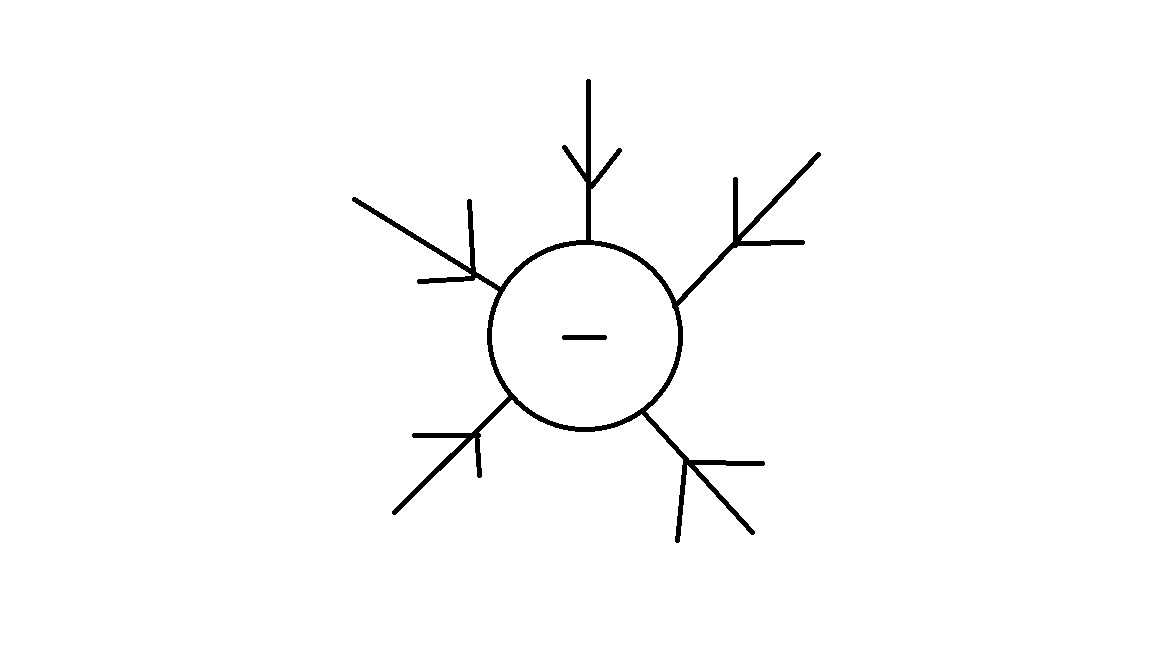Electric field
Electric field
The electric field created by a charge is present throughout space at all times, whether or not there is another charge around to feel its effects. The electric field created by a charge penetrates through matter. The field permeates the neighboring space, biding its time until it can affect anything brought into its space of interaction.
The Main Idea
To be exact, the definition of the Electric Field is as follows:
The electric field is a region around a charged particle or object within which a force would be exerted on other objects.
If we put a charged particle at a location and it experiences a force, it would be logical to assume that there is something present that is interacting with the particle. This "virtual force" is in essence the electric field.
A Mathematical Model
The electric field can be expressed mathematically as follows:
[math]\displaystyle{ {\vec{F_{net}} = 0 \Leftrightarrow \frac{d\vec{v}}{dt}} = 0 }[/math]
[math]\displaystyle{ {\vec{F_{2}} = {q_{1}}{\vec{E_{1}}} \Leftrightarrow \frac{d\vec{v}}{dt}} }[/math]
which can be translated to postulate that the force on particle 2 is determined by the charge of particle 2 and the electric field.
Examples
The following examples are to test your basic understanding of the Electric Field. For more examples that test your knowledge of all three of the laws, peruse the class textbook.
Simple
Which way is the electric field going for a negatively charged particle?
It's easy to see that the electric field is pointing toward the negatively charged particle. The electric field is tending toward the negatively charged particle.
Middling
Two charged objects are separated by a distance d. The first charge is larger in magnitude than the second charge:
A) The first charge exerts a larger force on the second charge.
B) The second charge exerts a larger force on the first charge.
C) The charges exert forces on each other that are equal in magnitude and opposite in direction.
D) The charges exert forces on each other equal in magnitude and pointing in the same direction.
The answer is of course C, which can be reasoned even by an extension of Newton's Third Law. Using the simple equation in this page, it is also possible to derive and reason this result. Notice that the forces are opposite in direction! The equations above relate vectors, an important concept on physics.
Difficult
The number of electric field lines passing through a unit cross sectional area is indicative of:
A)field direction
B)charge density
C)field strength
D)charge motion
E)rate of energy transfer
The answer is C, since the number of electric field lines through area is how field strength can be qualitatively and quantitatively determined.
Connectedness
The electric field is made up. It's a lie. It's a concept that an English intellectual by the name of Michael Faraday made up centuries ago to think about the universe in a different way. But it this concept that is Faraday's greatest gift to the world. The electric field allows us to think about point charges, charge distributions, and current. It allows us to better understand electricity, a concept that would go on to spur some of the greatest inventions of the entire history of humankind. And now, with advances in areas like quantum computing and bioengineering where circuits are regularly employed to push the boundaries of science and engineering, we have Michael Faraday to thank. Devices that save lives or improve their quality, such as neuroprosthetics or pacemakers, rely on the principles theorized by Faraday long ago.
History
It was in 1831 that Hans Christian Oersted demonstrated that by applying electric current through a wire, a magnetic field could be produced. How was this verified? The needle from a nearby compass was deflected accordingly. Michael Faraday would go on to demonstrate electromagnetic induction, in which Faraday resolved the issue of whether magnetism could produce electricity (which it could, if the magnetic effect was set in motion, creating a resulting current). But it was not until 1864 that a Scottish physicist by the name of James Clerk Maxwell came along to provide a unifying statement for electromagnetism by way of his groundbreaking publication 'Dynamical Theory of the Electric Field'. Maxwell's equations were a set of four equations that expressed, mathematically, the behaviors in which electric and magnetic fields participated.
See also
External links
Interactive Electric Field [1]
Electric Field Simulator [2]
References
The following references were used while writing this page:
http://www.rare-earth-magnets.com/history-of-magnetism-and-electricity
Sherwood, Bruce A. "2.1 The Momentum Principle." Matter & Interactions. By Ruth W. Chabay. 4th ed. Vol. 1. N.p.: John Wiley & Sons, 2015. 45-50. Print. Modern Mechanics.
